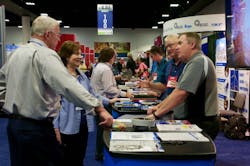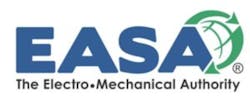Electromechanical professionals gather at the 2018 EASA Convention
The 2018 Electrical Apparatus Service Association Inc. (EASA) Convention will feature 23 education sessions, three general sessions, three days of exhibits, two social events, one optional service center tour and five additional optional tours June 24-26 at the Wisconsin Center in Milwaukee, Wisconsin.
Visit the Process Flow Network at Booth 650
The convention will include education mixed with other enriching experiences for attendees to learn more about the area, such as a St. Louis Cardinals versus Milwaukee Brewers game; a Bikes, Beers and Bustling Milwaukee tour; riverboat cruise; and Milwaukee’s Museum Experience.
The New Product Theater provides an opportunity for companies that are EASA exhibitors to show EASA Convention attendees their latest products with demonstrations and presentations.
The education portion of the event will feature speakers and presenters with expertise in the field. The following programs are just a few that will be taking place:
Opening Remarks and Keynote
Troy Hazard: Purpose, Passion, People, Profits
Troy Hazard has founded 12 businesses over two decades, and in that time, there are very few situations that he has not experienced and survived. In this keynote, Hazard will provide information about how business owners can have a more purposeful view.
Introduction to Problem Solving and Root Cause Failure Analysis
Mike Howell, EASA Technical Support Specialist
The goal of root cause failure analysis (RCFA) is to determine the root cause(s) of a failure. But to be effective, RCFA must take place within the context of a practical, problem-solving methodology or framework. The analysis may be of little value unless feasible countermeasures are implemented to prevent recurrence. This session will provide an intro to problem solving and RCFA that can be applied generically to any process.
Pump Curves and Affinity Laws in Layman’s Terms
Gene Vogel, EASA Pump and Vibration Specialist
This program will discuss Murphy’s Law for pump repair warranties that says if you fixed the motor and the pump doesn’t work right, the problem is the motor; if you fixed the pump and the motor fails, the problem is the pump. To deal with this, service center owners, managers and engineers need to understand the factors that determine pump performance and the load imposed on motors. This session will provide that practical understanding without overly technical equations.
Open Technical Forum
Facilitator: Austin Bonnett, Bonnett Engineering, Gallatin, EASA Technical
Support Team
Join EASA’s world-renowned engineering team for an open discussion of technical questions and issues.
Understanding the Interactions of Pumps, Motors and Drives
Bill Livoti, WEG (on behalf of Hydraulic Institute)
AC induction motors drive approximately 90 percent of all pump systems. Variable-speed controls power an ever-growing portion of these pumping systems. The pump, motor and drive are components of the total "pump system." Understanding how these react to each other is critical to achieve higher reliability and improved performance. Many plants evaluate individual components rather than considering the interactions of motors, pumps and drives within the total system. This session will focus on how the pump, motor and drive function and operate as individual components and a total system.
EASA Industry Research: Deeper into the Data
Michael Marks, Indian River Consulting Group, Melbourne, Florida, and Jerry Peerbolte, J. Peerbolte & Associates, Fort Smith, Arkansas
The findings revealed from EASA’s latest industry research were among the highlights of the 2017 convention. Evolving developments in how customers source products and services are becoming more important to future success. This session will discuss what else has been learned about EASA businesses, markets and customers.
The Economy: A Bend in the Road
Brian Beaulieu, ITR Economics, Manchester, NH
Brian Beaulieu will describe the status of the current business cycle of the U.S. and global economy and forecast where the economy is heading. The session will look at the upside opportunities and what risks lie ahead for the economy and explain why it is important to understand the difference between a potential slump in activity (2019) versus the extended upside potential looking into the future. The session will discuss effectively managing labor costs and other pressures stemming from business cycle changes.
Wisconsin Center | Milwaukee
EXHIBITION SCHEDULE
June 24, 1:00 p.m.–4:30 p.m.
June 25, 12:00 p.m.–4:00 p.m.
June 26, 9:00 a.m.–12:00 p.m.

